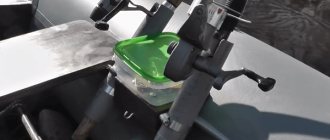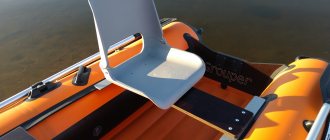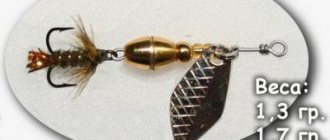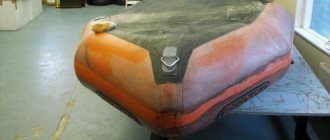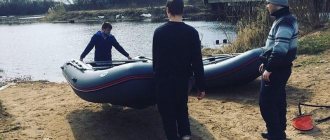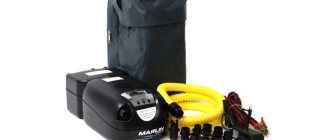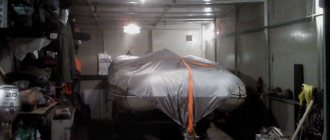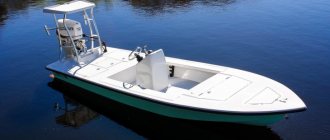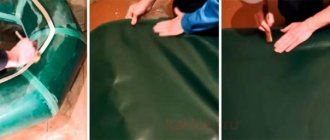Spinning rod holders for boats
5 minutes Author: Konstantin Pavlov 1997
A fishing rod holder for a boat is a practical device used for convenient storage of fishing rods while fishing all types of fish from a boat. Such a device helps determine a safe place to install the form during:
- waiting for a bite on float or bottom tackle;
- after catching the fish and freeing it from the hooks;
- movement across a body of water;
- trolling;
- control of the craft when approaching the coast.
The holder is also suitable for installing a landing net, which will not interfere and is always at hand.
A spinning rod stand is a common item that can be purchased at a fishing store. If you have a simple tool and desire, it is possible to make such a product of the required modification (different from the factory one) with your own hands.
Types and features
Spinning holders come in various designs and designs. They are installed on boats made of:
The spinning rod holder is purchased or manufactured for specific installation conditions and in accordance with the size of the fishing rod. The following are classified according to the number of seats in the stand:
- single - compact device for one form;
- double – convenient to use for two spinning rods: for small and large – heavy wobblers;
- targas with a large number of glass holders. This type of stand is most often used in large water areas when traveling on a boat. Excellent for trolling: tackle with baits is thrown into the water, and the rods are securely attached to the glasses. With this placement, there is no overlap of gear, you can see which fishing rod worked.
The fishing rod holder is attached to the side or bench of the boat in various ways:
- using a clamp. One of the most used fasteners. It has a number of advantages over other installations: it is suitable for any type of boat, it simplifies installation - dismantling the holder, it is easy to control the screw tightening;
- gluing for PVC boats. Fits perfectly with quick release stands. You can glue several lower parts in different places on the side of the boat. During the fishing process, moving along the perimeter of the floating device, the upper part of the holder is rearranged by simply snapping it in;
- fastening with bolts or screws. Mainly used for permanent installation on wooden and metal boats. One of the most reliable connections, but requires periodic inspection and careful monitoring during operation. This connection is susceptible to corrosion, so lubricants should be used to protect against rust.
For trolling, use holders with glasses that have a vertical position or an angle of inclination relative to the horizontal of no more than 600. The trolling method of fishing involves catching fish on a moving boat. Therefore, to securely hold the form, a high angle of its installation in the stand is designed.
For comfortable use, stands for float and feeder rods are made with the glass tilted at an angle of no more than 450, corresponding to the conditions for attaching fishing rods on the shore.
A holder with an adjustable tilt of the holding part is suitable for the spinning rod, so that the spinner has the opportunity to independently set the installation position of the spinning rods that is convenient for himself.
Types of holders
Its presence is especially important when wading fishing, when the spinning rod cannot be placed on the shore. When boat fishing, it is convenient to use two or more rods - those that are not yet needed can be placed in holders. In addition, the rod can be secured in the holder while moving from point to point. Thanks to this design, the risk of spinning rod breakage both on shore and boat fishing is minimized.
The boat holder can be fixed or have degrees of freedom . In the second case, you can change the angle of inclination of the structure and rotate it around its axis. In this case, the holder can be securely fixed in any of these positions.
Depending on the material used, boat holders can be metal, composite or plastic. The former are distinguished by maximum durability, but the metal is difficult to process. Plastic models are very light and easy to make, but fastening from this material is very unreliable. The best option for making it yourself is combination holders with a plastic cup and a metal fastener.
DIY spinning rod holder
Purchased industrial devices for holding spinning rods for floating craft have a number of advantages:
- practical device;
- nice looking;
- multifunctional features;
- detachable fittings made of reliable materials.
The main disadvantage of a stand for attaching fishing rods in a commercially produced boat is its price. Much cheaper, you can make a holder for a spinning rod with your own hands, using minimal labor costs, having:
- a clear representation of the final result - drawing;
- improvised materials;
- accessible tool;
- desire and diligence.
How to make a spinning rod holder for a PVC boat? To do this you will need:
- clamp;
- PVC pipe diameter 50 mm, length 1 m;
- metal perforated corner 20 cm long;
- plastic clamps 20 cm and 10 cm long.
- Using a hacksaw, the pipe is cut into 25 cm sections.
- Using a drill, holes are drilled in the lower part of the prepared pipe sections to allow passage of clamps.
- Using clamps, the structure is assembled on the basis of a perforated corner.
The resulting holder is easy to attach and maintain; the clamp presses the corner to the seat board or is attached to the transom of a PVC boat.
Holder with clamp from a meat grinder
A holder with a clamp can also be made on the basis of an old unnecessary meat grinder.
For this:
- saw off its upper part, the one where the meat is placed, leaving only the clamp;
- drill 2 holes in the clamp;
- take a metal plate and screw it with two bolts to the clamp (you can take a plate with holes, a piece of metal corner, as in the example above, or any metal plate in which you need to drill holes yourself);
- screw it to it through the third hole in the metal plate
- pipe clamp;
- secure the plumbing plastic pipe in the clamp, with or without a cutout for the coil.
Metal holder made of fittings and clamps
Used for installing float and bottom fishing rods. Due to the use of a hinge joint, it has an inclined front part, and the rear part is made in the form of a ring.
To make it you will need:
- fittings – 1 meter section;
- clamp;
- M5 bolts;
- welding machine;
- drill, set of drills;
- hammer, core;
- yew;
- paint or primer;
- brush.
Manufacturing procedure:
- reinforcement is being prepared:
- bends according to the pattern;
- holes are drilled in the designated locations;
- the resulting structure is connected to the swivel;
- painted.
Fishing rod holder - selection criteria
Shore fishing becomes much easier if you use a special rod holder. Without it, you can easily fish with spinning rods and fly fishing. Today, there are a very large number of structures of this kind - they are divided into simple ones (resembling a slingshot) and more complex ones, where several fishing rods can be placed at once.
Despite this, there are still fishermen who consider such fishing accessories absolutely unnecessary. They build these flyers directly on the shore.
Classification
According to the installation method, spinning rod holders are divided into two main categories:
- combined;
- separate.
In combined models, the fishing rod stand is integral with the mount to the boat, this increases installation mobility and speed, but such a holder has large dimensions during transportation.
On the other hand, a separate holder, in which the mounting adapter and stand are connected directly when installed in the boat, has smaller transport dimensions, but requires time-consuming assembly.
Holders are also divided by design; they also come in two types:
- glass vertical;
- horned with horizontal rings.
In the first type of construction, the rod is placed with the handle in a deep glass at a position of 50 degrees to the vertical. Such models are used for trolling fishing.
The second type of stand involves placing the rods as on the shore, with angles from zero to 30-40 degrees. In front of this design there is a slingshot, in the back there is a ring. This type of arrangement is best suited for feeders or floaters.
Based on the number of fishing rods that can be placed on one stand, rod holders are divided into:
- single;
- double;
- targhee.
Everything is clear with single and double holders; their name indicates the number of fishing rods that can be placed in them. Targs are multi-form holders, so to speak. They are most often used in trolling and are a large curved pipe with glasses attached to it.
With a small number of them, the targa is attached to the opposite sides of the vessel in a spacer at one point. If the structure is large, then on each side of the boat it is fastened in two places.
Criterias of choice
Height
A fishing rod stand with a height adjuster, designed for one fishing rod, usually has a telescopic design, and is fixed in a certain position by an eccentric with a plastic handle or a metal screw. The last method of fastening is the most reliable.
Much more common are special universal racks. They are made of metal, and their upper part is threaded. Usually the kit comes with several replaceable heads, among which there are ordinary flyers of various shapes and sizes. In addition to them, there is a wide head (it can be used with a wide variety of fishing technologies), as well as a head with which you can attach several rods at once.
Such a stand is also universal for the reason that you can attach a fish tank to it, install a special alarm there, which will emit sound signals when a fish approaches or when it bites, and so on.
Latch in the stand
The retainer in the stand can be made of plastic or metal. Metal, of course, is more reliable, but a design with such a fastening will cost significantly more compared to plastic products. If you plan to use this installation regularly, then it may make sense to purchase a more expensive but durable design so that it will serve reliably for several years.
Reliability
This indicator is influenced by many important points. For example, replacement heads made from hard rubber will last longer compared to plastic.
However, such products have a number of disadvantages, the most important of which is the inability to stick them into solid ground. When you plan to fish from a rocky shore, it is better to use a self-supporting structure.
Its base includes three or four metal tubes made of steel or aluminum alloy. They also function using the telescopic method. Thanks to the ability to adjust the legs, they can be placed on the surface at almost any angle. A certain height can be fixed using a collet clamp or an eccentric.
Manufacturer
There are holders for fishing rods of both domestic and foreign production. Domestic designs, as a rule, are more bulky, however, they have one major advantage over imported ones - they were created taking into account Russian fishing characteristics. Foreign manufacturers did not take care of this point, so their products can sometimes fail at the most crucial moment.
In addition, even metal foreign stands in some cases are not suitable for our conditions. They are made of painted steel, so damage to the paint layer leads to the development of rust, which ultimately destroys the entire stand. Domestic structures are made from aluminum and its alloys - they are not afraid of corrosion.
Boat equipment for fishing with float and onboard fishing rods
HomeContentVideoVideo
Starnak
Blog entry date: 08/14/2017 Blog entry date: 08/15/2017
5
A PVC boat is such a thing, it’s not enough to just buy it. Immediately after purchase, you need to purchase (and/or make yourself) a whole bunch of various accessories to make fishing possible at all, and even with maximum comfort. In this video, by popular demand from anglers, I tell you how my boat is currently equipped. Let me remind you that I use the boat for float fishing, as well as for fishing with onboard fishing rods.
Of course, the first thing you need to purchase is life jackets and, if necessary, other water safety equipment. But I won’t dwell on this, since my task is to talk specifically about fishing accessories. I will tell you in the order of assembling the boat and going fishing. And then returning from it.
The first is a piece of dermantine (vinyl leather) measuring 160*270 cm. It is used when unfolding and folding the boat, protects against punctures, cuts, and after fishing prevents sand, pebbles and dirt from sticking to the wet bottom.
I modified the “piglet” pump on the advice of one of the subscribers. I bought an adapter and a piece of transparent tube. The adapter has a screw in the center that presses down the valve. Now inflating (and downloading) the boat is an autonomous operation. I connected the pump, turned it on, and went on about my business. A small thing, but convenient.
A piece of carpet is placed in an inflated boat with installed floors. For my boat the size was 1*2 meters. Moreover, on one side it is placed in the corner between the cylinder and the floor, and on the other side it is placed slightly overlapping. This is done precisely from the side from which the fishing takes place and where the main dirt is formed. Since I started using this mat, cleaning the boat floor after fishing involves taking the mat out and shaking it out. You don't even need to wash the floors. You should take not the cheapest carpet, but the next most expensive one, with a rubberized base. It doesn't slip and is more practical.
The boat, of course, needs anchors. We will need two anchors to be able to stretch securely on them and stand in one place. I received two caterpillar tracks, which from time immemorial have been used as boat anchors. I put them in order, cleaned them, painted them, and equipped them with rope. By the way, a rope is needed for the bow anchor 30 meters, and for the stern anchor 20 meters. Nothing less. Although at first it appears that these are very long ropes, in reality they are not. Just right for reliable anchoring at depths of up to 10-12 meters. And if it’s deeper, you’ll need even longer ropes.
Modern fishing is unthinkable without an echo sounder. The sonar transducer must be secured to the transom somehow for it to work properly. Since I walk under an electric motor (or with oars), I use a Praktik ER6 Pro2 echo sounder, for which the manufacturer provides a proprietary bracket for mounting the sensor. That's exactly what I use. It is comfortable, has all the necessary adjustments and does not cause any complaints.
Let's go on the water! When we have decided on the fishing point, the first thing to do is to mark it somehow. After all, sometimes moving from a point even by a couple of meters is unacceptable (for example, you stand on a window in the bushes). In large expanses of water, you won’t even notice how the breeze moves you ten meters. What if it’s foggy in the morning?
To mark the selected fishing point, we need a fairly simple but extremely necessary accessory, a buoy. This is a piece of foam plastic, equipped with a thick fishing line and with a heavy weight (about 100-200 grams) at the end. At the beginning, when installing the boat, it shows the selected place, then, during the fishing process, it controls the shift of the boat, whether it has moved from the baited point. In the case of float fishing, it is convenient to throw bait relative to it so that it falls as compactly as possible in the same place.
The boat cage is strikingly different from its coastal counterpart. If on the shore we use cages 3-4 meters long, then in a boat this length is excessive and even harmful (fishing often takes place at a depth of 3-4 meters). Therefore, a spacious two-meter (or so) fish tank is selected for the boat. From experience, a cage with large rings is more convenient, it is easier to put caught fish in it and it feels better there.
My fish tank is cheap, Chinese, but smartly made. Rubberized mesh, metal rims, fabric upper section. I refer the reader to my video about choosing a cage for fishing from the shore for details on why this is good. But buying a fish tank for a boat is not all. Next you need fasteners and a fuse to prevent the fish tank from running away. This is not fishing from the shore, where a holder is stuck into the ground and the cage is installed. And even if he falls into the water, nothing particularly terrible will happen. The slightest miscalculation on the boat, and you are without a catch and without a cage.
The mounting for my boat cage is made from a small piece of thick 15mm plywood. There are 2 plastic plumbing pipe holders installed on it, with which it is attached to the oar. In general, we were very lucky; ordinary 32 mm plastic holders are ideal for mounting on a standard boat oar, as if they were specially made for this purpose. At a cost of 5-10 rubles, they are an ideal means of fastening all kinds of accessories; there is room for your imagination to run wild.
On the other side, a part of the cage holder is attached to the nut in the center. The nut is recessed into the plywood (the sampling is done with a Forstner drill) so as not to cling to the boat and not damage the sides. Plumbing holders are also secured with special bolts with countersunk heads so that they do not protrude beyond the plywood. The entire holder is coated with yacht varnish, since constant contact with water combined with exposure to the sun very quickly leads to damage to the plywood, especially if it is not waterproof.
The cage is attached with a standard bolt to the holder, the holder is fastened to the oar and pressed with a handrail. The entire design ensures reliable fixation of the cage in a comfortable position, its neck is straightened and positioned in a convenient way, the fish can be lowered into it without looking.
To be on the safe side, a rope is attached to the top or next ring of the cage, and a carabiner is hung on the rope. This is an additional safety system so that the cage does not go under water if it somehow becomes unfastened from the oar. After installing the cage on the paddle mount, the carabiner is fastened to the rail and prevents loss of the cage.
The third degree of protection is made of foam floats, hung using electrical ties along the rim of one of the upper rings of the cage. They are supposed to provide buoyancy for the cage just in case, but they also serve another very important purpose. They provide unloading of the upper part of the cage. If there are no floats, then the slightest current or lively fish inside the cage begin to unscrew the fasteners. Unloading solves this problem.
A boat landing net is also very different from a shore landing net. Neither long nor light (and therefore fragile) handles are needed. You need a spacious, roomy landing net with a short handle in case you catch a good trophy or fish with a float rod with thin leashes. I bought mine in the same place where I bought the fish tank for absolutely ridiculous money (compared to the company). At the same time, it also has a mesh lined with rubber and is also foldable, so it does not take up much space in the transport position.
The next accessory will not be useful to everyone. But if someone fishes from the side or, especially, has adopted broken-tip onboard fishing rods, then you should pay attention to this piece of boat equipment. This is a long piece of plywood, my board has dimensions of 1500 * 170 * 9 mm, which on one side is equipped with the same plumbing holders as the fasteners for the fish tank, and on the other side flat magnets are glued to it.
You may have already seen this board in my videos of fishing with side rods. We place brockens on it and they stand there reliably in any wave. As practice has shown, you can also put a cup of tea on it (in relatively calm weather), and also come up with a lot of other uses. The same magnets can be used to attach a container with a nozzle and many other small things. Of course, like the cage fasteners, the plywood is coated with two layers of yacht varnish to prevent drying out and premature deterioration.
One thing, all boats have oars located differently, either exactly along the side or at a certain angle. Therefore, before making fasteners, you need to pump up the boat and try the board in place so that it then stands level in the working position. Also note that the fasteners are shifted to the side of the plywood that is external to the boat, while the other side rests on the side. If you make a fastener in the middle, it will “walk” on it and nothing good will come of it.
We went fishing, caught a good catch, and the fish tank was difficult to get out of the water. What's next? It was on the shore that he threw it on the grass and the problem was solved. In the boat you need somewhere to put this wet fish tank with struggling fish that splash mucus and water everywhere. Alternatively, you can pour the catch into the bucket that contained the bait. But, there is a much more correct method, which becomes the only one if a lot of fish are caught and they all don’t fit into the bucket. Take a large soft PVC bucket and the entire cage with the catch is completely immersed in it. The bucket closes with a zipper and in this form goes to the shore. Because it is sealed, there is no water or mucus in the boat. And you can deal with the catch already on the shore. Rinse and dry the fish tank there. This is not a necessary thing, but it significantly adds comfort at the end of the fishing trip.
On the shore, when the boat is already unloaded, it must be washed. After our fishing with bait, at least the side from which fishing takes place is very dirty. All the fish are taken through it and this also does not add to its purity. In order to wash the boat comfortably, you will need a regular large sponge, which can be purchased at any hardware store. It would also be a good idea to use a large towel to wipe the boat dry after washing, thus drying faster.
In conclusion, I want to say that work to improve comfort while boat fishing is ongoing and, perhaps, there will be more to tell next season. There is a leisurely search for anchors that hold the bottom better than tracks. Work is underway to create a buoy that will automatically fix itself at the depth where it was thrown overboard. There is an idea that the landing net should also be secured somehow before it falls overboard. Although the consequences will not be as sad as in the case of a cage, it will still be unpleasant. We are thinking about a convenient location for the table with attachments, etc. Here you can improve almost unlimitedly.
I would also like to thank Alexey Statsenko (aka Optimist) for his invaluable help in equipping the boat, both in ideas and in their implementation.
Tags: homemade boat
3
See also: 08/17/2017 Kola 2021 - kayaking Lovozero-Afanasia-Kurga PART-I // Nikolay Nikolaevich (Nikolka13) 08/17/2017 Kola 2021 - kayaking Lovozero-Afanasia-Kurga PART-II // Nikolay Nikolaevich (Nikolka13 ) 08/17/2017 Kola 2021 - kayaking Lovozero-Afanasia-Kurga PART-III // Nikolay Nikolaevich (Nikolka13) 08/18/2017 Gambling fishing // Dmitry Salapin (Starnak)
Register or log in to comment.
AVP58
-> Blog post
Boat equipment for float fishing…
15.08.2017 09:59:55
Dmitry, there are several points: 1. You always say that laziness is an important character trait, so the question is: why paint the tracks? Or is there a secret meaning in this too? Maybe after experimenting with the perfect aroma, the fish went for the smell of paint 2. But seriously, when attaching a fish tank, it is better to place the rail on top of the board, but under the fish cage mount. Then it will be pinched there and even if two fasteners on the oars break at once, the cage will remain hanging. Accordingly, triple insurance will become unnecessary, and this will significantly reduce the ropes under your feet, which makes fishing from a boat more convenient and safe. 3. It is better to use a combination wrench for 13 (open-end and cap). We use the rozhkov for its intended purpose, and tie it to the cord behind the cap. Then the key will be its continuation and will not get confused and interfere. We attach the second end of the cord with a carabiner to the rail or to additional eyelets that can be installed on the transom. 4. You can also tie a landing net, but this is important if you are fishing alone in a boat. 5. To wash a boat, you can attach a pump attachment to a screwdriver. All the same, you take him with you in the machine for mixing bait, let him work off his bread. The hoses also don’t take up much space, but they’re convenient. NHNCH!
Starnak
-> Blog post
Boat equipment for float fishing…
15.08.2017 15:11:08
1 - Dirt from rust, the boat is white Too lazy to wash it every time, but will it even wash off? And then I painted it once and that was it. 2 - Yes, you can put a rail there, I agree. But the additional carabiner weighs nothing, and it gives me peace of mind. I have already pulled out an almost drowned fish tank twice, with my modest boating experience. And the floats are more for unloading. 3 - I wanted to do just that, but there was only this key on the market, and the next day I had to go fishing. That's why I now have this key, defective 5 - I don't understand what kind of attachment it is?
AVP58
-> Blog post
Boat equipment for float fishing…
15.08.2017 15:56:41
5- PM sent the link
Sergey B
-> Blog post
Boat equipment for float fishing…
15.08.2017 17:52:45
I am using plumbing latches. This will eliminate the need for gluing fasteners onto cylinders. And you can get by without a key by replacing all connections with XT-60 connectors. Well, I also use a wattmeter, information about the remaining capacity is very useful.
Sergey B
-> Blog post
Boat equipment for float fishing…
15.08.2017 17:57:18
Yes, here is the battery connection https://yadi.sk/i/duv3Q4VX3M32GP
Starnak
-> Blog post
Boat equipment for float fishing…
15.08.2017 17:55:34
The engine has a ten-position display meter, so you can roughly orient yourself.
Sergey B
-> Blog post
Boat equipment for float fishing…
15.08.2017 18:12:53
Well, I have a budget motor. What kind of batteries do you have? I’m eyeing lithium-polymer ones because of their lightness, but Chubais is in no hurry to produce them, and I still don’t dare order from the Chinese.
Starnak
-> Blog post
Boat equipment for float fishing…
15.08.2017 18:30:49
Regular heavy ones I have 95 Ah, Sergei has 105 Ah.
Sergey B
-> Blog post
Boat equipment for float fishing…
15.08.2017 18:58:58
Sorry.
Variety of fishing rod holders
Pegs
The peg is one of the oldest types of fishing rod stands. It is used when fishing with one rod using a feeder. This design allows you to obtain the necessary line tension so that when there is a bite, the alarm will go off in time. You can make these stands yourself from wood, or you can purchase them at a fishing store.
If you use a high-quality fishing rod for fishing, then it is better to use a purchased peg, otherwise it can be damaged.
Racks
This type of stand allows you to hold the rod by the handle. But in windy or rainy weather, you won’t be able to notice the bite in a timely manner, since the upper part of the rod will not be very stable. The post is driven into the ground in the same way as the pegs, so it is not possible to use them everywhere.
Tripods
Tripods are always made of metal tubes, so their reliability is at its best. These devices come in one-piece and two-piece, and each of them is very convenient to adjust in height.
Modern rod-pod
This type of stand is most common among experienced fishermen. They are supported on two tripods or on four vertical posts at once.
It is worth noting that the tripod is equipped with only one hinge joint, so it is wiser to purchase a stand with vertical stands , each of which is individually adjustable in height. Due to this feature, the rod can be installed at any convenient angle to the shore. If the water in the reservoir is stagnant, the rod is placed parallel to the shore.
How to increase your fish catch?
Over 7 years of active fishing, I have found dozens of ways to improve the bite. Here are the most effective ones:
- Bite activator . This pheromone additive attracts fish most strongly in cold and warm water. Discussion of the bite activator “Hungry Fish”.
- Increased gear sensitivity. Read the appropriate manuals for your specific type of gear.
- Pheromone -based lures .
Holder for onboard fishing rods based on UKB
This option is suitable for both short side fishing rods and conventional long float, bottom and spinning tackle. It can be used for trolling.
It is mounted on adjustable mounts for cans (lyktros-likpaz system) of the inflatable boat, which run along the sides from the inside. If there are none, you can glue them. These mounts are convenient because you can move the cans as you please, adjusting the location of the crew and things in the boat. The holder can also be moved forward and backward along the length of the cable cable.
The basis of the structure is a short wooden (or plastic, PVC, metal) block, one of the sides of which (adjacent to the board) is beveled. A pipe is attached to it, into which the fishing rod is inserted.
There are three ways to get such a holder:
- buy a completely finished structure (UCB) in a store;
- buy a base in the store - a block - and independently attach a pipe to it in which the fishing rod will be placed;
- make the holder completely with your own hands.
Making a holder for an onboard fishing rod with your own hands
The base can be made from a wooden block of suitable size.
To do this you need:
- saw off one of its sides so that it lies flat on the side of the boat;
- drill a longitudinal hole in it;
- cut a groove so that it fits onto the rail;
- coat the block with several layers of varnish so that it lasts a long time (the best option is yacht varnish, the protective coating made from it is the most durable).
For fixing fishing rods, a PVC plumbing pipe is best suited.
A good option is to place two pieces of it on different sides of the base of the holder. Make cutouts in them for the spinning rod leg if you are going to fish with this type of reel. Thanks to these cutouts, the rods will be clearly fixed in the holder without twisting. It is much more convenient to use this design.
An important advantage of plastic plumbing pipes is that they will not damage the fishing rod. Ready-made holders for onboard fishing rods, which you can buy in a store, often have metal pipes. When the boat constantly rocks on the waves and - especially - when crossing a pond with oars or under a motor, fishing rods in such metal glasses are easily injured.
Plastic pipes are attached to the block using a pipe clamp. They can be placed at different angles.
You can attach a plastic food container to the bar. The result is a convenient storage for baits, in which they will always be at hand.
Self-production
The simplest design is a roughly processed spear, stuck into the bank or into the bottom of a reservoir, on which the fishing rod itself is placed. However, there are homemade structures made of metal that can last for a long time.
The idea of the design is quite simple - just take a small piece of aluminum pipe of a suitable diameter (any other pipe will do - steel, PVC, metal-plastic, etc.) and a metal rod. A small slot is made in the pipe the width of your hand so that, if necessary, you can quickly take the fishing rod.
Then a hole is made for the rod, which will serve as a leg for the rack. It is better to make the structure itself collapsible to make transporting it as convenient as possible. The fishing rod will be secured in such a holder directly to the handle. By using this device, you can gain a decent amount of free space and time when biting, when every second counts.
A group of fishermen revealed the name of the secret bait during interrogation.
How to choose a spinning rod holder for a PVC boat
When fishing with a spinning rod from a PVC boat, the main inconvenience for the fisherman is the instability of this craft.
It is almost impossible to constantly hold the spinning rod in your hand and control the boat. When fishing by trolling, the spinning rod must also be securely fastened, so fishermen who fish by track or trolling cannot do without a spinning rod holder for a PVC boat. Such devices allow you to securely fasten the fishing rod and even, when biting a large fish, keep the spinning rod from falling into the water.
How to make a boat holder
To make a boat holder you will need:
- clamp;
- plastic pipe;
- a light alloy channel (a duralumin one is perfect);
- connecting bolts.
The first step is to drill a hole in the upper heel of the clamp and secure a short piece of channel with a bolt. Then in the other heel you need to secure a short piece in the same way. On a long section of the channel, you need to mount a section of PVC pipe with a plug placed at the bottom, which will not allow the butt of the spinning rod to fall down.
The inner surface of the pipe can be covered with fabric, sheet foam rubber or other soft material. Thanks to this, the risk of damage to the rod will be minimized.
Holder requirements
Spinning rod holders can vary significantly depending on the fishing method used. Basic requirements for this device:
- The “glass” of the holder must match the size of the spinning rod handle.
- With this device, the spinning rod should be securely fixed and not fall out even during strong jerks of the fish.
- The holder must be mobile and, if necessary, installed in any part of the boat.
- Device models must be reliably protected from corrosion. The best option is to purchase a holder made of high-quality plastic or stainless steel.
- Not least important is the external aesthetics of this device.
Popular holder models
UKB No. 3 is a holder that allows you to install two spinning rods at the same time. The poles can be installed strictly vertically or at an angle of 45 degrees. Several such devices can be installed on one watercraft. The product is made of high-quality materials that can easily withstand high loads during jerks of strong fish or hooking of tackle when retrieving. Price – 300 rubles.
Scotty 230 Power Lock Rod Holders are a reinforced modification of the holder for spinning rods from the famous Canadian company “Scotty”. The device body is made of high quality plastic and is equipped with a rotary coupling. The kit includes a universal mount that allows you to install the product both vertically and horizontally on any surface, including can be installed on a PVC boat. The spinning rod holder has a locking ring that prevents the tackle from being lost while trolling. Price – 3800 rubles.
Rod holder RH900R – the device is made of anodized aluminum. The holder copes well with high loads during fishing and is not subject to corrosion. To install the product on inflatable boats, use the mount included with the device, which is glued in a place where the holder will not interfere with the control of the boat. The cost of the device is 1600 rubles.
Kolibri is a Ukrainian-made product that is characterized by low cost and quality. The device consists of two parts, the spinning rod holder itself and the mount, which is glued to the PVC boat. The product can be easily removed at the end of fishing and installed when necessary. Cost – 300 rubles.
Avacha are easy-to-use devices that are mounted on board, equipped with a long glass that securely holds even long fishing rods. The glasses are equipped with a plastic liner that protects the fishing rod handle from wear during fishing. The body of the glass is made of nickel-plated steel and has a presentable appearance.
Leg holder
In addition to belt holders, there are also models that are attached to the leg. You can also make a similar structure yourself, the main thing is to make a reliable fastening that will not allow it to slip during use.
However, holders that attach to the belt are much more convenient and practical. They do not restrict movement and are securely held by straps; in addition, the belt holder can have many spacious compartments in addition to the mount for a spinning rod.
How to make a holder with your own hands
Making a holder yourself is not difficult. To do this you will need the following materials and tools:
- The fishing rod is inserted into the glass of the device and you can engage in spinning fishing both while moving and while standing
Plumbing polypropylene pipe with a diameter of 50 mm and a length of 0.5 meters.
- Car clamp with a diameter of 40 - 60 mm.
- Furniture hinge – 1 pc.
- Screwdriver.
- Hacksaw for metal.
The manufacturing process of the holder is carried out in the following sequence:
- Using a hacksaw for metal, a piece 30 cm long is cut from a plumbing pipe.
- Then, a clamp is screwed to the furniture hinge. Without tightening the clamp fastening bolts to the end, a piece of pipe is installed into it, after which it is necessary to tighten the bolts until they stop.
- The furniture hinge fastening is screwed to the can with self-tapping screws. This ensures reliable fixation of the spinning rod holder.
- The fishing rod is inserted into the glass of the device and you can engage in spinning fishing both while moving and while standing.
- When the product is not in use , it can be easily moved to a horizontal position.
- You can make a device from scrap materials.
For this you will need:
- A piece of plywood.
- A piece of stainless steel with a diameter of 40 mm.
- Two small mounts for the holder.
- Screwdriver.
- Glue.
- Electric drill and feather drill with a diameter of 40 mm.
- Hacksaw for metal.
Plywood must be treated with a special compound that does not allow the material to absorb water. A rectangle 20 cm wide and 40 cm long is cut out of plywood. 2 holes with a diameter of 40 mm must be made in the plywood at equal distances from each other.
Using a hacksaw, you need to cut 2 pieces of 40 cm long from the stainless pipe. These pieces are inserted into the holes of the plywood so that the distance at the bottom of the product is equal to the height of the side. The junction of the plywood and the stainless pipe is fixed using waterproof glue.
At two corners, which will be located directly on the cylinder, fastenings are installed using self-tapping screws, which are then glued to the boat hull. The lower part of the stainless pipes, which will rest on the bottom of the boat, should be covered with some soft material, such as rubber.
Thus, you will get a high-quality homemade holding device for 2 fishing rods, which can be used with a PVC boat, or with any other watercraft.
Device fixation options
There are several options for mounting rod holders for PVC boats. For example:
- Using bolted connections . This method is used only for boats that have holes for bolts or can be made in the sides. As a rule, these are wooden and plastic boats, since holes cannot be drilled in inflatable rubber or PVC models.
- Using screws . This technology for attaching spinning holders can be used both for wooden boats and for inflatable models made of polyvinyl chloride (attachment is carried out to plastic or wooden benches and transoms). But this method of fixation has two significant drawbacks: the holes from the screws spoil the structural elements of the swimming craft, the connections become loose over time, which contributes to the breakage of the holder and the loss of the spinning rod.
- Using a clamp . Such fastenings partially preserve the internal structural elements of rubber and PVC boats. But they are also not without drawbacks: when fixed to a bench, the device will interfere with the fisherman’s landing; when attached to the transom, it will control the motor. Therefore, this fastening method is suitable for fixing the holder on boat sides.
- Adhesive joints . This technology for fastening rod holders is intended for watercraft made of polyvinyl chloride. But some people glue them to the sides of plastic boats. Modern adhesive compositions provide fairly strong connections, but problems arise when assembling the floating craft into a stowed state.
Fishing rod stands made of wood or plastic are considered the most durable and reliable.
Attaching the spinning rod holder to the boat
Most devices that can be used on a PVC boat are installed using an adapter. The adapter is attached to the boat using the gluing method. Any place on the watercraft that does not interfere with boat control is suitable for this purpose.
You can install several adapters, so to change the position of the spinning rod on the boat, you just need to rearrange the product. Homemade spinning rods are installed on PVC boats, also using an adapter that is attached to plywood impregnated with a special water-repellent compound. The plywood is glued to the PVC boat in any place convenient for placing the product.
PVC pipe holder
PVC pipes are the best material for making a cup for the butt of a spinning rod:
- they can be purchased at any building materials store or plumbing store;
- they are inexpensive;
- PVC pipe is lightweight;
- easy to process;
- durable enough to withstand any test.
To make a simple holder, you only need to add a mount to it, with which it will be fixed on a belt or in a boat.
Blitz tips
- A holder for a spinning rod for a PVC boat should be selected only from those companies that have been working on the Russian market for a long time and have proven themselves to be the best
When choosing a holding product for a PVC boat, the diameter of the glass should be slightly smaller than the diameter of the spinning rod , so that you can pick up the spinning rod at any time without difficulty; too large a diameter of the device is also undesirable, because when reeling, the spinning rod will swing too much and hit the surface of the product .
